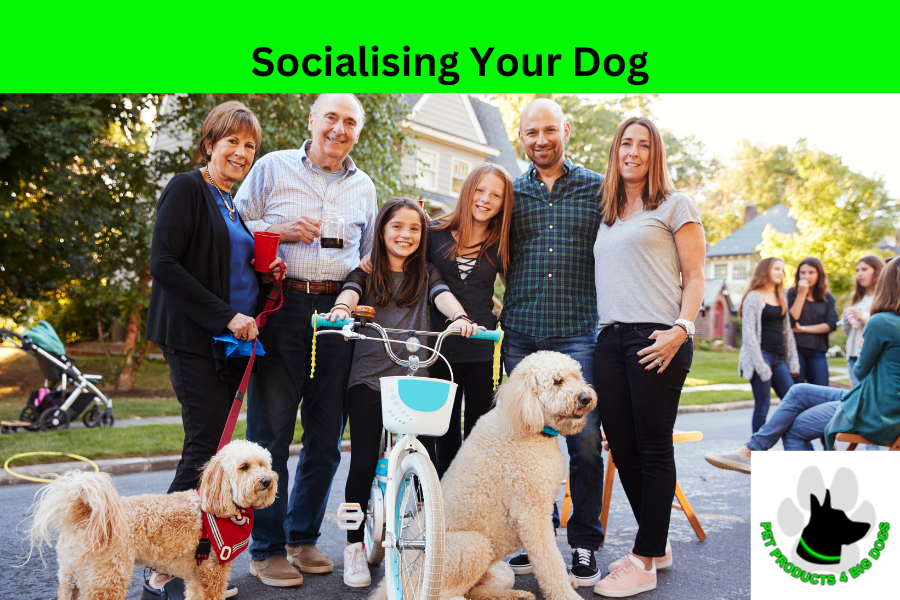Socialising a dog is very important, especially as a pup, they learn habits and learn manners. These are my personal reviews and perspectives … but hope you’ll find my thoughts useful.
How to Socialise Your Dog
Start Early
Yes, I absolutely know that they need to be immunised fully (plus 2 weeks after the last shot) before they should be out and about. However, you can implement other strategies to get socialisation happening sooner. For a start, puppy preschool is a great way; where you can socialise with other immunised pups in a learning type environment. The other thing you can do is invite friends or relatives around who you know are fully immunised. When Theo was a pup, Caesar (a decade or so older) was like a big brother and part of the family. My yard was safe and of course his yard was safe. He got to hang out with the big boy for quality one-one-one doggy time.
Have Early Socialisation Trips
Another fabulous strategy is visits to a Bunnings hardware store. Dogs are allowed in there in a trolley, your arms or muzzled. For a pup (pop down a blanket first, so their paws won’t slip through) the trolley is perfect. It’s not actually socialisation with other dogs you’re seeking here, but people contact. Your pup will be exposed to men, women and children, giving them a huge range of contact and pats and ‘owww, isn’t your pup cute’. The staff are sure to stop by and say hello and it’s a great way to get your dog used to different sounds, different people and different environments. At first, the rattling of the trolley might be a little scary, so go slow and make it fun. Remember your treats and make it a regular thing. The next time, your pooch won’t even notice the trolley noises and just be so excited to see the big wide world. In the early days, even make it a weekly event, even if you really don’t need to buy anything – but I’m sure something will end up popped into the trolley (besides your pup). Remember though, when you get out, be sure to carry your pup all the way to the car, until those vaccinations are fully in place.
I was told by a staff member at Kmart, that dogs are allowed in there too – but must be in a trolley. I’ve not actually tried that one, but check your local store for its rules. As far as I know, supermarkets are a no-no due to the food factor.
Café Training
Another one to start early is café training – take some water, treats and a blanket once your pooch’s vaccination period allows and seek out an outdoor café. Again, great to expose them to people and sounds, but also to teach them good obedience and behaviour. This is not an opportunity for them to try and steal food or misbehave, but rather, to learn to be well-behaved, social and a pleasure for everyone to have around.
Visitor Training
I won’t go into this too much as it’s in the realm of dog training, and whilst I’m probably close to 35 years’ experience, I’m not a dog training expert. However, as with anything dog, it’s good to start early. Dogs get excited when visitors come and especially pups that will grow up to being a big dog, need to learn control early on. You hardly want Nana and Pop to visit and be mowed down at the door by your 40 kg ‘baby’. Whether it’s mat training, or using a crate, or purely getting them to sit and wait to be greeted, get a system going. Hyping them up at the door isn’t a great strategy and won’t be your friend later as they grow into being a big dog.
On that note, make a point of having visitors a common thing, so that they are used to it and get to know that visitors are normal. It’s all about getting habits into practice and exposing your dog on a regular basis.
Children
Ok, this is an awkward one. Some people just don’t educate their children very well and they will hit a dog (there is a difference between patting and hitting), or allow their children to walk up to a strange dog without asking the owner. I’ve even heard owners say their dog doesn’t like being patted and then get berated by the adult that well, then they shouldn’t be around people! Then, of course, some parents are completely absent and let their children run wild. So, my best strategy has been to very quickly say to the child (with a smile and nice tone) “we need to be gentle when patting a doggy”. Most children will listen and adapt accordingly, however, if the child ignores you, move on quickly – your dog doesn’t need that exposure. On the other hand, some parents are fabulous and will ask permission first. I always say “thank you, yes, my dog is very child-friendly”. Whilst there are coloured leads that indicate whether a dog is approachable or not, the public at large are not aware of this, so if you’ve a touchy dog, be aware of your surroundings and be aware a child can run up without warning.
Walk When It’s Busy
As winter is drawing in and it’s getting darker sooner, this is a little harder. Mostly people walk their dogs between 4pm and 6pm. Ask Google and the time is 6pm to 9pm, but personally, I find, once the sun is down (in suburbia at least) the walkers are all but gone. So, to give my dog social contact with other dogs, I plan to walk during that time. Not only do you get to meet lots of people and say hello, but so does your dog. Watch the body language of the dogs and their owners. If you’re approaching a dog or owner, which is looking highly uncomfortable, or clearly is avoiding you, get the message and give them space. They know their own dog better than anyone else and it’s not up to you to decide your dog is friendly so it must be ok to approach. However, if say hello is clearly ok by the dog and the owner, then it’s great to allow the dogs to say hello and be sociable.
Camping, Hiking or Other Adventures
A well-socialised dog will love to go on your weekend adventures with you. I, for one, love camping and having a four-legged companion is fabulous. More and more camping sites are becoming dog-friendly, so start your pup young with the experience, so that it’s nothing scary for them. If your dog is crate trained, even better, but if you’ve an exceedingly large dog, this might not be practical. Pack some of their usual things, bed, blanket, toys, bowls etc and always their usual food. I often will skip brekky for my pooch prior to a long drive, just so their tummy is ok and then once I’ve arrived have a little water and then food. Don’t forget also to stop along the way every couple of hours for a wee break. Again, start this practice early and go as often as you can – not only will it be comfortable for your dog, but it’s a great way to spend a weekend. Again, be respectful of other people and dogs and always keep your dog on a lead or in your enclosure area.
Have a well socialised pooch makes you and them getting out and about is a pawsitive experience for your both. 🐾 Have a doglightful day!

